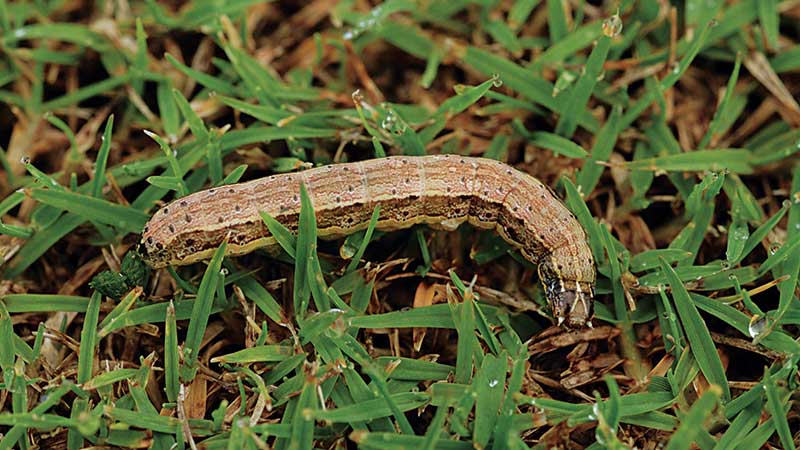‘Monstrous’ fall armyworms damaging turf in northern climates

Superintendents can identify the turf-loving fall armyworm by the upside-down Y on its head. Most common in the Southeast, the pest can ravage golf courses without mitigation. (Photo by: Lyle Buss, University of Florida)
Fall armyworms, typically a problem for Southern golf courses, wreaked havoc from Ohio to the East Coast this year, causing significant damage in Pittsburgh and other cities not used to seeing the pest.
“I heard about it on Twitter hitting Morgantown, W.V., so I started getting worried,” said John Shaw, superintendent of Valley Brook CC south of Pittsburgh in McMurray, Pa. Within a few weeks, he noticed some brown patches near his practice tees and on a fairway slope that had been too steep to treat for grubs and worms.
Shaw said damage at Valley Brook was very limited because he treats his course for grubs, but a buddy in the area sent him pictures of heavily blighted areas, saying he was experiencing the worst dollar spot outbreak he’d ever seen. Shaw responded that he should look for armyworms. Within a few minutes, he got texts back with images of the fall armyworm caterpillar with its signature Y-shaped markings on its head.
Penn State University turfgrass science professor Ben McGraw, Ph.D., said Pennsylvania is having its worst fall armyworm outbreak in about 10 years. Typically, the pest stays to the south because it dies off during cold winters, but storms can blow moths northward and lead to occasional outbreaks.
“Last week was the brunt of it,” McGraw said at the beginning of September about the Pennsylvania outbreak. “People are just figuring it out now after turf has collapsed. It should be pretty much over here. Places to the north might be a week behind us.”
The Ohio State University’s Buckeye Yard and Garden onLine news site that shares research from extension offices, nursery and turf professors issued a notice at the end of August, detailing a larger-than-usual outbreak in portions of the state.
Curtis E. Young, Ph.D., one of the alert’s authors and an Ohio Extension educator, said, “The whole state of Ohio seems to be experiencing a major outbreak of the fall armyworm, from south to north and east to west. This is very unusual for Ohio. It could be that the fall armyworm is spread across Ohio every year, but this year, it is a monstrous outbreak.”
He added that he’s heard reports of fall armyworms being spotted in Illinois and Indiana, far west of their typical regions. Unusually large numbers of worms have also been hitting traditional zones from Oklahoma to South Carolina, Young said, so more moths might be in the air where storms can carry them far and wide.
“We believe adults from those outbreaks were picked up in the storm front that came from the south across much of Ohio about four weeks ago,” OSU researchers said. “The adults of these moths have been known to travel 500 miles, even more, in 24 hours. They can get into the jet stream and move vast distances, then drop down to find suitable host plants.”
When the caterpillars move into a region, they eat until there’s no food left or they enter their next development stage. The worms eat grass leaves, not the roots, so OSU researchers say damaged turf can come back, but it needs to be watered to keep the areas cool and hydrated as late summer heat can bake the soil, killing roots.










